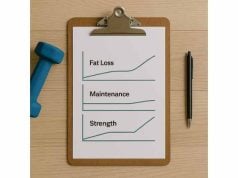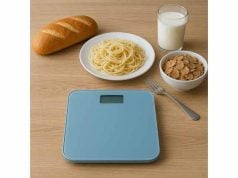
You can do everything “right” and still stall. The scale wobbles, waist measurements freeze, training feels heavy, and motivation slides. Cutting another 300 calories looks logical—but often makes adherence, sleep, and strength worse. Sometimes the fastest way forward is the counterintuitive one: raise calories on purpose to restore output, curb rebound eating, and restart fat loss. This guide shows you when that move is warranted, how much to add, and how to structure a short maintenance or diet-break phase without losing momentum. If you are mid-plateau, pair this article with our practical troubleshooting roadmap so your decision is based on trend data, not a frustrating week.
Table of Contents
- When to raise calories in a stall
- A simple two-week decision tree
- Signs you need more energy
- How to raise calories safely
- Diet breaks vs. refeeds
- Who should not increase intake
- Examples and case studies
- Frequently Asked Questions
When to raise calories in a stall
Before you touch calories, verify that you are in a true stall. Daily weights are noisy. Sodium, glycogen, menstrual phase, late meals, travel, and sleep loss can hide fat loss for one to three weeks. A stall is two to four weeks of flat weekly weight averages, no change in waist/hip measurements, and static photos/clothes fit—with consistent steps, training, protein, and sleep.
Why increasing calories can work:
- Adherence first. Deep deficits raise fatigue and hunger. That drives weekend overeating and bites/tastes that quietly erase your weekday deficit. A small increase often stabilizes appetite and portions so your weekly average finally sits below maintenance.
- Output matters. When calories are too low, you move less without noticing (NEAT drops), and training quality slides. A bit more energy can restore steps, lifts, and recovery, improving the “calories out” side.
- Water masks progress. Stress, poor sleep, and hard training inflate water retention. Eating a touch more, sleeping better, and lifting cleaner can lower water weight even as calories rise slightly.
When to not raise calories yet:
- Your weekend intake is unstructured (drinks, takeout, grazing).
- Steps plunge Friday–Sunday.
- Protein is below 1.6–2.2 g/kg goal body weight.
- You have only one week of flat data.
Fix those fundamentals first. If you do need a refresher on the core pieces (calories, protein, steps), skim our concise starter guide so your baseline is solid before manipulating intake.
What to look for before raising calories:
- Two to four weeks of flat weekly average weight and waist.
- Strength slipping or stalling across lifts at the same RPE.
- Daytime sleepiness, poor training drive, persistent cold, or low mood.
- Adherence fraying: late-night snacking, “I’ll start Monday,” or frequent unlogged extras.
Once those signs stack and your behaviors are consistent, a diet break or a small calorie bump is likely the right lever.
A simple two-week decision tree
Use this quick framework to decide whether to hold, add steps, or raise calories. Run it exactly for two weeks; reassess with data, not vibes.
Step 1 — Confirm the stall (Week 0 data):
- Weigh daily, compute the weekly average.
- Measure waist/hips once per week, same conditions.
- Log steps (7-day average), protein average, and sleep hours.
- Note cycle phase if applicable.
If the weekly average and waist have been flat for 2–4 weeks with consistent inputs → go to Step 2.
Step 2 — Movement first (Week 1):
- Add +1,000–2,000 steps/day (attach 10–12 minute walks to meals and calls).
- Keep calories and protein unchanged.
- Hold for 7 days, then recompute the weekly averages.
If the trend moves (weight/waist down), keep going. If still flat → Step 3.
Step 3 — Small calorie bump (Week 2):
- Increase calories by +150–250 kcal/day on all days or +200–300 kcal on training days only.
- Keep protein constant; allocate the bump mainly to carbs near training (improves performance and adherence).
- Maintain the higher step floor.
- Sleep target 7–9 hours, caffeine cutoff 8–10 hours before bed.
After 7 days, compute a new weekly average and re-measure waist. If you see improved performance, steadier appetite, easier adherence, and either waist down or weight average down over the next 2–3 weeks, the intervention is working. If not, consider a structured diet break at calculated maintenance for 1–2+ weeks to reset recovery and decision-making.
For a clean method to verify a true plateau before making changes, see our quick guide on how to confirm a stall in 2–4 weeks.
Signs you need more energy
Calories fund recovery, training quality, movement, and mood. When they are too low for your current context, your body sends reliable signals. Respect them; they are not weakness—they are feedback.
Training signals
- Performance droop: you cannot hit prior reps at the same RPE across two to three sessions per lift.
- Stagnant bar speed: warm-ups feel heavy; top sets grind despite adequate rest.
- Shrinking training volume: you cut accessories “to survive the day.”
- Soreness lag: DOMS lingers longer than usual, especially with poor sleep.
Physiology and mood
- Persistent cold, low motivation, or irritability.
- Sleep quality dips: early morning awakenings, restless nights, or heavy reliance on late caffeine.
- Hunger swings: calm until evening, then strong cravings or late-night “foraging.”
Behavioral tells
- Weekend compensation: Friday–Sunday calories balloon versus weekdays.
- Snack creep: bites, tastes, and BLTs (bites, licks, tastes) rise.
- Food focus: you are always thinking about the next meal or “saving up” for events.
What changes with a small calorie bump
- Gym performance stabilizes in 3–7 days; lifts feel snappier.
- Hunger smooths: fewer evening raids; easier portion control at restaurants.
- NEAT drifts up naturally (you stand, fidget, and walk more).
- Water retention may drop as stress and sleep improve, sometimes lowering the scale.
If strength has been sliding, pair your decision with the cues we outline in what gym performance says about your diet. Training quality is one of the cleanest indicators that intake is too low for now—even if the math looks okay on paper.
How to raise calories safely
Raising calories is not a free-for-all. It is a small, targeted change with clear rules, designed to restore output and adherence while protecting leanness.
1) Choose your format
- Linear bump: +150–250 kcal every day. Best for general fatigue, sleep issues, and adherence.
- Training-day bump: +200–300 kcal on lifting days only. Best when training performance is the main issue.
2) Protect the fundamentals
- Protein steady: 1.6–2.2 g/kg goal body weight. Keep 25–40 g at breakfast and lunch.
- Fiber steady: 25–35 g/day to control appetite.
- Steps steady or up: keep the higher step floor you set in the decision tree.
3) Allocate the calories wisely
- Favor carbs near training (60–120 minutes pre- and post-workout) to improve session quality and recovery.
- Keep fats moderate at meals surrounding training; place richer fats at other meals if desired.
- Keep alcohol within a planned budget; late-night drinks undermine sleep and mask progress.
4) Structure the bump with food you already eat
- Examples (~200–250 kcal):
- 1 medium banana + 1 cup low-fat Greek yogurt
- 60–80 g cooked rice added to your post-workout bowl
- 1 slice sourdough + 1 tbsp jam + 1 boiled egg
- 250 ml low-fat chocolate milk post-workout
5) Monitor what matters
- Weekly averages for weight and waist.
- Session notes: RPE, reps held, and how warm-ups feel.
- Hunger and mood: evening cravings, decision fatigue.
6) Decide after two to three weeks
- If training and adherence improve and the weekly average or waist trends down, continue until your next planned break.
- If not, consider a maintenance phase or adjust macros (more carbs, slightly lower fats) while holding total calories. For macro tuning, see our guide on how to adjust calories and macros without breaking adherence.
Diet breaks vs. refeeds
Both tools add calories, but they solve different problems. Choose based on your bottleneck: fatigue and adherence across weeks vs. a short mental reset.
Refeeds (1–3 days)
- What: small calorie rise (typically +250–400 kcal), mostly carbs, with protein unchanged.
- When useful: before or after tough training blocks, before travel, or to cushion a social weekend.
- What they do: improve training feel and adherence, reduce the urge to binge-restrict, and make weekdays easier.
- What they do not do: they are not magic for “boosting metabolism” in a measurable way.
Diet breaks (1–2+ weeks)
- What: return to calculated maintenance calories while keeping protein/steps/training steady.
- When useful: true stalls after fundamentals are solid; persistent fatigue; strength sliding for weeks; high stress or poor sleep; after long dieting blocks.
- What they do: restore mood and training quality, reduce water retention, and consolidate habits at a sustainable intake. Many people resume fat loss more calmly and adhere better afterward.
How to pick
- If your data problem is one weekend or a harsh week of training, try 1–2 refeed days.
- If your problem is weeks of low drive, poor sleep, and flat averages, take a diet break.
- In both cases, keep protein high, keep steps up, and plan meals (structure prevents “maintenance creep”).
For help deciding which tool fits your context, review the simple contrasts in refeeds vs. diet breaks.
Who should not increase intake
Sometimes the problem is not calories. If your biggest leaks are weekend overeating, alcohol, or step collapse, raising calories will not fix the root cause—and may worsen it.
Hold your calories and fix these first:
- Unstructured weekends: plan a two-day budget, one indulgence per meal, and a step floor both days.
- Alcohol drift: decide type and count ahead of time; keep the last drink 3–4 hours before bed to protect sleep.
- NEAT drops: attach 10–12 minute walks to meals and calls; schedule a 30–45 minute easy session on both weekend days.
- Inaccurate tracking: weigh oils and dressings; pre-portion calorie-dense snacks; log condiments, nibbles, and lattes.
If your weekends routinely erase your weekday deficit, start with the targeted playbook in weekend overeating before you consider raising intake.
Medical and context cautions
- Pregnancy/postpartum: follow clinical guidance.
- Active eating disorder or high weight-checking anxiety: avoid calorie micromanagement; use clinician-guided metrics.
- Medications or conditions that affect fluid balance or appetite: discuss diet breaks and refeed structure with your clinician first.
Bottom line: raise calories after you have tightened structure and verified a true stall. Do not use a diet break to paper over chaotic habits.
Examples and case studies
Case A — The tired lifter (8 weeks into a cut)
- Data: 75 kg → 73.6 kg over 6 weeks, then flat 73.6–73.7 for 3 weeks. Waist flat at 78.5 cm. Steps 8.5k → 6.9k. Squat volume feels heavy; sleep 6.3 h.
- Intervention: +250 kcal on training days (mostly carbs), steps +1,500/day, caffeine cutoff earlier, 7.5 h in bed.
- Outcome (3 weeks): Weekly average drops to 73.1 kg, waist 77.8 cm, squat reps return, fewer evening cravings.
Why it worked: More carbs near training improved performance; better sleep reduced water and cravings; higher steps restored “calories out.”
Case B — The weekend eraser
- Data: Weekdays at 1,800 kcal (maintenance ≈ 2,300). Fri–Sun unplanned drinks/takeout. Steps drop to 4–5k. Weight average flat; waist slightly up.
- Intervention: No calorie increase. Two-day weekend budget, 1 indulgence/meal, 8k step floor, pre-event protein snack.
- Outcome (3 weeks): Weight average −0.8 kg; waist −1.2 cm. Training feels the same, but adherence is stable.
Why it worked: The problem was behavior drift, not low calories.
Case C — Long block diet break
- Data: 16 weeks into a cut; progress slowed; strength and mood down; sleep fragmented. True stall confirmed for 3 weeks.
- Intervention: Diet break at maintenance for 2 weeks; protein steady; steps steady; small performance emphasis in training.
- Outcome (4 weeks total): Water drops; clothes fit better; motivation returns. After resuming a small deficit, the trend restarts.
Why it worked: Recovery and NEAT improved; adherence reset; training quality came back.
Templates you can copy
- Training-day bump: +60–80 g cooked rice post-lift, +1 medium banana pre-lift.
- Linear bump: add 1 cup low-fat yogurt + berries at breakfast, or an extra fist of potatoes at dinner.
- Diet-break day: keep meal times, add a starch serving to two meals, and include a fruit-forward dessert once per day.
Decision rule to remember: change one lever for two weeks, judge by weekly averages (weight and waist), training feel, and adherence—not by a single morning or a salty dinner.
Frequently Asked Questions
How many calories should I add during a stall?
Start small: +150–250 kcal/day (or +200–300 kcal on training days only). Keep protein and steps steady. Allocate most of the increase to carbs near training. Reassess after two to three weeks using weekly weight averages and waist measurements.
Will raising calories make me gain fat?
Not if it is small, structured, and paired with solid steps, protein, and sleep. Many people see better training, fewer binges, and steadier adherence—leading to improved weekly averages and smaller waists over two to four weeks. Judge by trends, not one weigh-in.
How long should a diet break last?
Typically 1–2+ weeks at calculated maintenance, with protein high and steps/training steady. Shorter than a week often feels chaotic; longer than two weeks is fine if strength, mood, and life demands warrant it. Resume a small deficit when performance and sleep are stable.
Should I add carbs or fats when increasing calories?
Favor carbs around training to improve performance and recovery; keep fats moderate and place richer fats away from workouts. Always hold protein steady at 1.6–2.2 g/kg goal body weight to protect lean mass and appetite control.
What if I feel hungrier after raising calories?
That can happen for a few days as routine shifts. Lean into protein and fiber at earlier meals, keep a planned evening snack, and hold steady for 7–10 days before judging. If hunger remains high and adherence worsens, switch to a maintenance diet break.
Can I raise calories if weekends are my problem?
Fix weekends first. Use a two-day budget, plan drinks, set a step floor, and keep one indulgence per meal. If your weekly average is still flat after two to four weeks of structured weekends, then test a small calorie bump or a short diet break.
References
- Effects of intermittent dieting with break periods on body composition and metabolic adaptation: a systematic review and meta-analysis 2025 (Systematic Review)
- Effects of Intermittent Energy Restriction Compared with Those of Continuous Energy Restriction on Body Composition and Cardiometabolic Risk Markers – A Systematic Review and Meta-Analysis of Randomized Controlled Trials in Adults 2024 (Systematic Review)
- Intermittent Energy Restriction Attenuates the Loss of Fat Free Mass in Resistance Trained Individuals. A Randomized Controlled Trial 2020 (RCT)
- International society of sports nutrition position stand: nutritional concerns of the female athlete 2023 (Guideline/Position Statement)
- Non-Exercise Activity Thermogenesis in Human Energy Homeostasis – Endotext – NCBI Bookshelf 2022 (Review)
Medical Disclaimer
This article offers general education about diet stalls, calorie adjustments, and maintenance strategies. It is not a substitute for personalized medical advice, diagnosis, or treatment. Always consult your licensed healthcare professional before changing your diet, exercise, or medications—especially if you have medical conditions or take prescriptions.
Share and Follow
If this guide clarified when raising calories actually helps, consider sharing it with a friend who is stuck in a stall. You are welcome to follow us on Facebook, X, or whichever network you use most for steady, practical updates.










